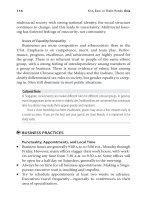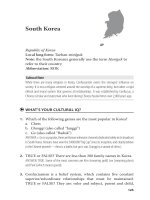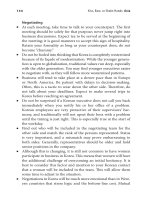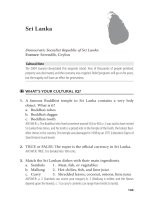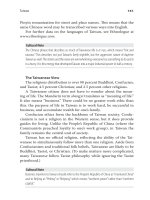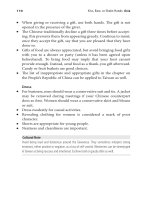How to Understand Business Finance Understand the Business Cycle Manage Your Assets Measure Business Performance Sunday Times Creating Success_4 ppt
Bạn đang xem bản rút gọn của tài liệu. Xem và tải ngay bản đầy đủ của tài liệu tại đây (181.53 KB, 18 trang )
62 How to Understand Business Finance
business it may be possible to go back to the owners and ask for
more money (ie appeal to relatives). In a large company with
shares quoted on the stock exchange, appealing to shareholders is
much more diffi cult.
In a large company, selling more shares to your shareholders
is known as a rights issue. Normally you need a good reason to ask
shareholders to put more money into a business. Asking for a cash
injection because of cash fl ow diffi culties is not considered a good
reason but rather a sign that the company is being run badly.
Get more business
While getting more business will not ease an immediate cash fl ow
problem it should help in the coming months as the cash starts to
fl ow in once more. It is essential, though, that this business is
profi table. In other words, the sales income must eventually
generate more cash than the costs going out or this will just
become a greater drain on your cash. Of course, getting more
business has a cost – there is the new sales eff ort, the promotional
spend – and in the short term this will make your cash fl ow
problems even worse. Spending your way out of cash fl ow
problems can work, but is high risk – not what your accountant
would call prudent.
5
Measuring business
performance – fi nancial
ratios
Table 5.1 gives a summary of the fi nancial performance of six
diff erent companies.
Which company is the best? It is diffi cult to say, and that is
why accountants have invented fi nancial ratios – to allow us to
compare one company’s performance with that of another. When
doing this we ought to be sure that we are comparing like with
Table 5.1 Financial performance
Company
Ace Best Cool Demon Excel First
Annual sales
(revenues)
100 120 150 160 180 200
Gross margin
(gross profi t)
80 80 75 90 100 140
Profi t
(earnings)
10 12 18 18 18 18
63
64 How to Understand Business Finance
like, those famous apples and pears – a pharmaceuticals business
compared to a chemical company may well not be considered a
fair or useful comparison. For one thing, the level of risk in each is
very diff erent, leading to diff erent expectations of what returns
these organisations should make.
The corollary of this statement is that a fi nancial ratio in
isolation is meaningless unless we can compare it to another
fi gure, a benchmark of some kind. We tend to do this intuitively
when calculating these numbers by relating it to a known target or
level of business performance.
Our competitors, at least the good ones, might make good
benchmarks, only they rarely publish accounts broken down to
the level required for us to make these comparisons. Even if they
do, the ratios used by one company might well be defi ned rather
diff erently in its accounts from the way you would understand
them. We are back with our apples and pears again. In practice,
companies tend to evaluate their performance against last year,
against budget, or against corporate targets sent down from on
high. None of these are very satisfactory benchmarks, since one is
history and two are inventions!
Interpreting ratios can also be misleading. You need to know
some background to an organisation to be able to explain its
ratios. Analysing percentage gross margin (explained below)
demonstrates this well.
All these ratios are based on a period of trading and a snapshot
of a company’s assets. Quoting these ratios to several decimal
places can lead to some meaningless comparisons – if the ratios
are close then so are the two performances. Try to avoid spurious
accuracy or you could turn into an accountant, and remember we
are only trying to understand them…
To overcome the short-term nature of ratios, some companies
will look at an average fi gure over a period of time (eg Shell use a
measure of ROACE – return on average capital employed).
Another issue is whether the accounts are quoting the same
period of sales. Accountants will often ‘annualise’ the sales by
multiplying the fi gure to represent 12 months’ activity (eg
multiplying a quarterly fi gure by four), but this can be misleading
65 Measuring Business Performance – Financial Ratios
if a business is seasonal, or a major external event (eg global
downturn or a major incident in the industry) has occurred.
Size
In terms of size, sales (or revenues) by value is most often used
as a measure of who is biggest. Using this measure, First is
clearly the largest company in Table 5.1. Other measures used
might be sales by volume rather than value, profi t, number of
sites (eg supermarkets), employees (for service-based
industries), product range, brand awareness, or even hits on the
company’s website.
It is also worth remembering that there is no point having
the largest sales if these are not profitable. We need to make a
trading profit, also known as profit before interest and tax
(PBIT) or operating profit, as there are various obligations a
company must meet from this profit. These are interest, tax
and dividends.
Dividends are often considered to be a way of
distributing the profi ts of a company back to its
shareholders. This can be misleading. A dividend is
usually a cash payment to the shareholders. In other
words it comes from cash! It is because a dividend
reduces the amount of net profi t that is retained in a
company that people talk about it coming from profi ts.
After paying interest, tax and dividends, whatever is left of the
profi t is left in the company to fund future activities. This is why it
is often known as retained earnings and is carried across to the
bottom half of the balance sheet.
66 How to Understand Business Finance
P&L account (income statement)
analysis
The basis of P&L account analysis is to consider each element
compared to the sales or revenues value (also known as the top
line). Sales shows the level of activity in this accounting period,
and the costs that should be linked to that activity.
Gross margin (gross profi t) percentage
Gross margin percentage is the gross margin divided by sales,
expressed as a percentage. In the example on page 67, Ace has a
gross margin percentage (GM%) of 80 per cent, Best 67 per cent,
Cool 50 per cent, Demon 60 per cent, Excel 56 per cent and First 70
per cent. Using this measure, Ace is the best performer. GM% is a
measure of how much profi t you are making on each unit of sales
after variable costs alone. Clearly, we would like this to be as high
as possible. GM% is not volume dependent because units of sales
are used to calculate both the top and bottom fi gures of the
equation. Hence, you can sell one unit of business at very high
margins and still make a loss!
Only two things infl uence GM%: the selling price and the
variable costs. The sales team are often the butt of criticism for
poor gross margins – with people saying, ‘It’s those prices they
give our stuff away for…’ We should remember that there are two
parts to GM%, and we should take a long, hard look at the variable
costs:
Variable selling expenses (VSE) – These include delivery •
costs, insurance, commissions, rebates and discounts,
some of which are negotiated by sales staff , and some of
which are part of the supply chain costs.
Raw material costs – We tend to point the fi nger at our •
purchasing departments, which are responsible for raw
67 Measuring Business Performance – Financial Ratios
material costs. However, raw material effi ciencies or
conversion rates, and levels of rework and waste, often
have a large impact on GM%. The decision whether to
make ourselves or buy in from others (toll manufacture,
subcontracting, purchase for resale or PFR) can also
aff ect GM%.
Product mix – When selling a range of diff erently priced •
(and costed) products and services, a change in the split
between higher margin and lower margin items can aff ect
GM%. This is often hard to prove in a business selling
many diff erent products and services, and so is a
favourite management excuse if GM% is below target.
Costs to sales (percentage)
Costs to sales is a popular measure used on many of the fi xed
costs in the P&L account. Depending on the type of business,
diff erent ratios will be used. For instance, a company selling
consumer products may examine its advertising and promotional
costs as a percentage of sales while a biotechnology company may
look at research costs as a percentage of sales.
Profi t before interest and tax (PBIT)
Profi t before interest and tax is a common level of profi t used for
many ratios. In large companies, interest and tax are managed
centrally, but in each business unit or division, this is the level of
profi t that managers control. Traditionally it has also been used
because there are diff erent levels of interest and tax in diff erent
countries and we can therefore compare more accurately across
borders if we use PBIT. Today, many companies negotiate funding
globally and arrange transfer pricing between countries to make
the profi ts in tax-friendly locations, and so this convention is
becoming less relevant.
68 How to Understand Business Finance
Return on sales (ROS) (or profi tability)
Return on sales is profi t (or earnings) as a percentage of sales, and
examines performance in relation to the bottom line (profi t or
earnings). In the example on page 63, Ace, Best and Excel have an
ROS of 10 per cent, Cool 12 per cent, Demon 11 per cent and First 9
per cent. Hence, on this metric Cool is delivering the highest
return of 12 pence in every pound of sales revenue.
If ROS falls from one period to the next, but GM% does not,
this indicates either a loss of sales volume or an increase in fi xed
costs. A line-by-line analysis of each cost (or expense) as a
percentage of sales can also indicate where management attention
may be required.
When you look at fi nancial ratios, it is important to ask
three questions:
How does it compare (with last year, another •
division, or a competitor)?
Why is it diff erent?•
Is that good or bad?•
For example, if our GM% has fallen since last year, is that
because we are discounting our prices, have raised our
cost of manufacture or service in order to improve our
image and move upmarket, or have entered a new
market for mass sales of the product at lower prices,
without changing our relationship and pricing to existing
customers? And in each case, is that a good thing that we
should continue or increase, or a bad thing that we
should fi nd ways to reverse?
69 Measuring Business Performance – Financial Ratios
Balance sheet analysis
In the example in Table 5.1 we can see that four of the companies
are delivering the same overall level of profi t (or earnings) and
that when compared to levels of sales (or revenues) Cool is best.
But what resources are tied up in generating these sales? This
leads us to an analysis of the balance sheet.
Table 5.2 shows some of the elements of the top half of a
balance sheet (the assets we have in a company).
Generally, there are two main elements – working capital and
fi xed assets.
Table 5.2 Company assets
Company
Ace Best Cool Demon Excel First
Working capital:
Stock
(inventories)
Debtors
(receivables)
Creditors
(payables)
Net working
capital
10
12
(8)
14
12
12
(14)
10
10
30
(20)
20
14
30
(12)
32
16
30
(14)
32
18
30
(18)
30
Fixed assets 20 25 30 30 35 35
Net assets 34 35 50 62 67 65
70 How to Understand Business Finance
Working capital
Working capital is generally made up of three elements: stock,
debtors and creditors. This information can normally be found on
any balance sheet (for instance in Table 2.14).
Stock (inventories)
As already pointed out, accountants value things at what they
cost. There are four main types of stock or inventories:
Raw materials – When raw materials are sourced from •
diff erent suppliers or at diff erent costs, the accountant’s
task of correctly valuing this stock can be a nightmare!
Work in progress (WIP) – Any goods, between leaving raw •
material stock and being passed as suitable for sale, are
classed as WIP. In a multi-stage process this can become a
considerable value, especially if WIP has to be moved
between sites to complete production. Again, if the same
items are produced at diff erent sites at diff erent costs,
another headache awaits the stock keeper at month end.
Finished goods – These are valued at what they have cost •
to make (or buy in for resale). The same problem exists in
valuing this stock.
Engineering spares – In a business with specialist •
equipment, considerable quantities of proprietary spares
may have to be held to limit any machine downtime when
breakdowns occur. There is always a trade-off to be made,
and often a company will have a breakdown spares and
maintenance contract with its equipment supplier, rather
than holding these items in stock itself.
Deciding the correct levels of stock is not simply a fi nancial
consideration, as stock is often equated with service levels or lead
times. Also, simple comparisons to sales can be misleading, as unit
for unit a diff erent value is assigned at each stage in manufacture.
71 Measuring Business Performance – Financial Ratios
Debtors (receivables)
This is the total amount of money owed to us by customers.
How do we know what is the right level? We can compare it to the
level of sales, calculating days of sales outstanding (DSO or debtor
days) using the following sum:
Debtors
×
numbers of days in accounting period in which
Sales sales generated
Hence the DSO for Ace is 44 days, Best: 37 days, Cool: 73 days,
Demon: 68 days, Excel: 61 days and First: 55 days. Immediately we
see 37 days as the target to beat.
It is hard when examining the value of debtors on a
balance sheet to decide what is a good DSO fi gure.
Hence, accountants use the DSO ratio to enable us to
make this judgement. DSO represents the average
amount of time we are giving our customers to pay their
bills. We can compare our DSO with that of others in our
industry or region, or against the payment terms we
have negotiated with our customers, to see how well we
are managing our debtors.
To see the exact amounts outstanding we would examine the aged
debtors profi le – the actual sums owed to us within 30, 60 or 90
days and any that are outstanding even longer than this.
Creditors (payables)
Supposing we buy and sell the same volume of goods, and get
the same number of days of credit from our suppliers that we
give to our customers. The amount of money we owe our
suppliers should be less than that owed by our debtors
(receivables). In other words, we expect to add some value
between raw materials and the selling price for fi nished goods.
72 How to Understand Business Finance
Thus, in Best we can see that with creditors (payables) exceeding
debtors (receivables), their suppliers are funding the company’s
working capital.
A useful ratio to measure how eff ectively we are using this
money to generate sales, is working capital as a percentage of
sales. Working capital to sales is 14 per cent for Ace, 8 per cent for
Best, 13 per cent for Cool, 20 per cent for Demon, 17 per cent for
Excel, and 15 per cent for First. It should come as no surprise that
Best performs well on this measure because of its high relative
levels of creditors (payables).
Fixed assets
Fixed assets (for example, factory equipment and machinery) do
not change in value from day to day, so managers cannot aff ect the
asset value reported in the books except by buying and selling
items. Hence, most management attention focuses on the other
part of our asset base.
It is worth remembering that accountants value fi xed assets at
their book value, which is the purchase cost less depreciation, to
take account of the reducing value of the assets as they wear out. It
is normal to hold a fi xed asset register which lists all the fi xed
assets a company owns and how they are depreciated to refl ect the
current book value.
Other assets
Although not mentioned in Table 5.2, companies often have other
assets. An obvious example is cash. In large companies this is not
included in a business unit’s accounts as cash is usually managed
centrally, and is therefore not necessarily available to that
operation. It is also sometimes taken to the bottom of the balance
sheet to off set short-term loans (eg an overdraft), thus reducing
interest charges.
73 Measuring Business Performance – Financial Ratios
Goodwill
Finally, there are also intangible assets such as goodwill. This
comes into play when a company buys another for more than the
book value of the assets. The diff erence between what was paid
and the book value of the assets is called goodwill. We can justify
it any way we like, but to accountants goodwill is just the
diff erence between these two numbers.
Asset turnover
Asset turnover is a measure of how eff ectively we are utilising all
the money tied up in the business. It is calculated by dividing the
sales from the P&L account by the net assets in the balance sheet.
So, in our example the asset turnovers are: Ace: 2.9, Best: 3.4,
Cool: 2.7, Demon: 2.6, Excel: 2.3 and First: 3.1. In other words, Best
is working the money tied up in the business (its assets) the
hardest. This is often referred to as ‘sweating the assets’, and
people often think of this as getting those workers in the
production plant to work harder. But really it’s not those assets we
can aff ect much on a day-to-day basis, compared to the working
capital, which is often infl uenced by all the other departments as
much as by production. Many companies operate well below their
production capacity, in which case the way for them to improve
their asset turnover is to raise sales volume, rather than just
concentrate on production.
Return on net assets (RONA)
RONA is a measure of how much profi t we are making on all the
money invested in the business. It’s a bit like asking, ‘What return
am I getting from the bank on the money I’ve got deposited?’ In a
business RONA is looking at the profi t generated, compared with
all the money that is tied up.
74 How to Understand Business Finance
Return on Net Assets =
PBIT
× 100%
Net Assets
Ace has a RONA of 29 per cent, Best 34 per cent, Cool 32 per cent,
Demon 29 per cent, Excel 23 per cent and First 28 per cent. So
although Ace is making less absolute profi t than Demon, it is
making a similar level of profi t for the money that is tied up in
the business.
Gearing (leverage)
Gearing tells us how much of the company is really owned by the bank!
Gearing =
Loans
× 100%
Capital Employed
Capital employed is a common term for all the funds on the
bottom half of the balance sheet and in UK accounting is the same
as the top half of a balance sheet. Clearly, the lower the gearing,
the less the company owes the bank and the greater the likelihood
that it could borrow more money if required.
6
Getting fi nance from the
bank
Introduction
The objective of this chapter is to provide a broad overview to
securing bank fi nance. There are many detailed volumes written
that can extend your knowledge if needed.
So you are setting up a new business or you have an existing
business, but there is one thing you have in common – you need
bank fi nance. Finance comes in many diff erent forms. The more
risk, the greater the potential reward to the lender.
While this chapter focuses on bank fi nance, it is worth
setting out the broad principles of other sources as shown in
table 6.1. Finance carries a cost; the equity cost is a share of
ownership and future profi ts/losses, while bank fi nance cost
comes in fees and interest. Late overdue tax payments can carry
a penalty and extended trade credit may be negated by
withdrawal of discounts for early settlement. The message –
consider your options!
75
76 How to Understand Business Finance
Table 6.1 Main types of fi nance
Risk factor
for lender
Type of
fi nance
Source Explanation
Lowest
risk
Bank debt High street and other
Banks provide funds
that require repayment,
plus interest. Usually
accompanied by
tangible security, either
from the business
assets, or the owners
personal assets
The lowest
risk because
of the
availability of
security to
cover the risk
of failure
Medium
risk
VAT, PAYE,
National
Insurance
and
Corporation
Tax
Monies owed to ‘the
taxman’ can be retained
on extended terms, and
by agreement, as a
source of temporary
fi nance. In times of
economic uncertainty
can be a very useful low
cost source, at other
times can be expensive
carrying penal interest
costs
Some priority
is given in
the event of
failure for the
payment of
‘preferential
creditors’
High risk Trade
credit
Credit given by
suppliers helps fi nance
the business, so the
longer it is given the
longer that fi nance is
supporting the
business. Often termed
‘the cheapest form of
credit’ because it
carries no cost
High risk
because no
security is
available and
in the event
of default
ranks behind
the bank and
the taxman
77 Getting Finance from the Bank
Highest
risk
Equity
or Share
capital
Permanent investment
in the business. Usually
provided by the
owners themselves
(also known as
shareholders), family
and friends. Also from
Business Angels &
Venture Capital Funds
The highest
risk as is the
last creditor
to be paid in
the event of
business
failure
Your relationship with the bank
Life is about relationships; whether they are personal or business
orientated. There is one thing in common – they always need
careful consideration.
We have established you want some bank fi nance. Where do
you go? Whom do you see? You could start by walking into your
high street bank, or maybe not…
One of the oldest sayings is: ‘It’s not what you know, but
who you know.’ Never a truer word spoken. It is essential that
you commence any bank relationship on the right footing, and
it is critical that you avoid at all costs being ‘turned down’ by
your bank – it is so hard to have a decision reversed in any walk
of life.
So, make sure the relationship starts on the right basis. Ask
yourself key questions about your knowledge of an individual
in banking; do I know anyone? Can any of my contacts
introduce me (and concurrently vouch for me)? My strongest
advice would be to always seek a personal introduction from a
friend, an accountant or solicitor you might know or another
business colleague.
Later on in this chapter we will discuss maintaining that
relationship, which is equally important.
78 How to Understand Business Finance
Purpose of bank fi nance
When seeking Bank fi nance, there are two broad categories your
requirement will fi t into:
a) Working Capital; that is to fi nance stock/raw material
purchases or to provide the fi nance to allow customers to take
extended credit ie to fi nance debtors.
b) Capital Expenditure; that is the purchase of land and
buildings, plant and machinery, investment in product
development and/or growth requiring support in paying
wages and buying materials ahead of launching that new
product or indeed another business.
It is important to consider why you need to borrow money:
Working Capital is generally provided by short-term •
overdraft where your bank account fl uctuates month by
month between credit and debit.
Working Capital can equally be provided by extending •
your trade credit, or negotiating delayed tax payments.
Capital Expenditure is generally provided by long-term •
loans, repayable in monthly instalments.
Capital Expenditure can equally be provided in other •
ways; for example the provision of a van could be
fi nanced by hire purchase, or taken on a lease agreement.
Having established why you need to borrow, this will have an
important bearing on how you present your plans to the bank.
Is your request viable?
A bank will only lend you money if it can reasonably expect to be
repaid. You need to be able to show your ability to repay, whether
it is a short-term overdraft or a longer term loan.
79 Getting Finance from the Bank
Some of what you need to cover is:
your track record;•
your historic results;•
a business plan (see below);•
last audited accounts;•
current and up-to-date management accounts;•
debtor and creditor lists;•
a budget for the current/next trading year;•
a cash fl ow forecast alongside the budget.•
The extent to which you can provide this information depends on
whether you are a new ‘start-up’ business, or an established
business that has been trading for many years and is seeking
fi nance for the fi rst time. However, consider this: even if you are a
brand new business, you have a track record and historic results
in your previous occupation that should be used to demonstrate
your expertise and/or ability.
The detail of a business plan is widely misunderstood. It does
not have to be a book. Indeed, it is better for all concerned if it
isn’t! Broadly it must cover ‘your story’ – how has the business
come about; some detail about the product/services; the
management of the business and its plans for the future; market
research undertaken to support assumptions and forecasts; and
the fi nancial requirements.
The sum of this information should enable the reader to make
a reasoned assessment on the viability of the proposition. Is the
product right, does the market research support the budgeted
sales, do the sums add up? Key will be does the business generate
suffi cient cash to repay its proposed borrowing from the bank?
A business is supplying various fashion chains and
supermarkets with clothing. All the stock they purchase is
done against confi rmed purchase orders from their clients.
All they have to do is have the stock manufactured to the



